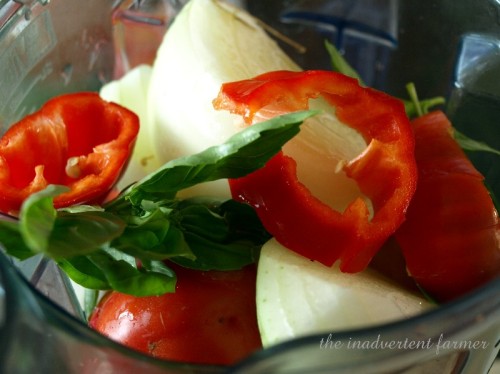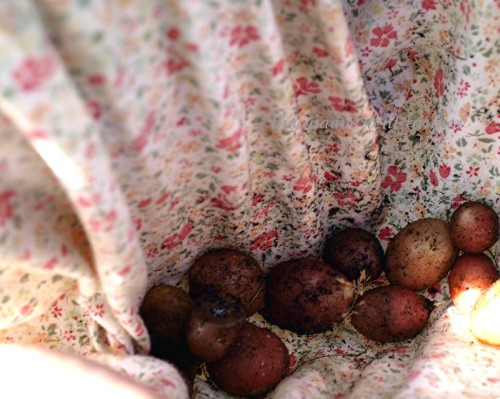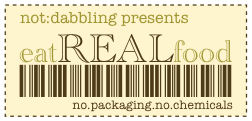Soil is an extremely important “product” as you surely know. I don’t care if you have thousands of acres or just one—-you must have good soil to have good health and good products. Not only does it make the vegetables or animals harvested taste better and be better for us it also can reduce or eliminate some work since disease and insect problems will be reduced or eliminated (depending on disease and/or pest of course).
Like most people we have had to work at improving our soil for the entire time we have been on this property. We did not get lucky enough to purchase perfect, organically cared for fluffy top soil. Not one drop of it.
Our property was not in very good shape when we first arrived since the previous owners rented the land to the neighbors for commercial beef and stripped off most of the trees (and top soil) AND strip contoured the ground for erosion control (the type of control now deemed very detrimental to soil and erroneous in the extreme). And though it still has room for improvement after all that hard use, we have been working very diligently at making it better and it shows. One thing that has been a “hitch in our get along” is the cost and convenience of finding some items. We are…and always have been, organic. In my area organic is still “out there” in the farming community and our local (and most not so local) mills carry only chemical versions of all amendments. Bummer.
So…we have had to think outside the box when it comes to improving our pastures beyond normal lime and a few other common amendments found everywhere. It is one thing to spend lots of money on kelp, green sand, bagged natural sources of phosphate and other needed amendments for your vegetable garden but it is much much harder when it comes to acreage. If you have one or two acres maybe it’s not so bad, but when you have more to cover it can be quite pricey at many hundreds of dollars per acre more than even conventional amendments are. Unless, of course, you really are a “hobby farmer”.
Of course each area is different and some organic amendments may be cheaper in your area. Obviously if you live in say… Maine…. kelp will be cheaper, but in my not very organic area and you don’t generally find the items organic gardeners need unless they ship it in (adding freight costs) or it is purchased in small home gardener 5 pound bags.
However, if you are like us and either live in an area with a low organic philosophy or have limited money to spend (or both) you can think outside the box like we have. And no…the ways I will list are not the do all end all of ideas, just some of our better and easier choices. We have tried many many things to improve our soil and not all have shown us results. At least not highly noticeable results. I will not list those since I would like to stick more with something that will absolutely work and not with things that are still theory, or were low yielding, here on our farm.
One thing we tried to improve our soil was to make movable feeders to feed our hay in every single day to our animals (For years! And sometimes it was very tedious!!). Beyond using the feeders we would also at times lay the hay on the ground if the area was clean –as in no manure recently there. We would of course move the spot each day, whether in the feeder or laid on the ground, feeding only enough hay for that day. We moved each not by just over a few feet either….we don’t want health issues of course. We would move the hay over by 40 or so feet eventually coming back and filling in the gaps. * Part of the reason for only feeding a day or two worth in a movable feeder was that we are very very hilly here and often had to move it by hand. 50lbs of hay still not eaten can be quite heavy to haul up a hill in a not so light feeder to move it out of a soggy manure filled spot in the rain*
Now as you wonder why we did this let me explain we had some “pastures” that literally had almost no top soil and grew only the rankest of weeds. To have skipped these spots and never grazed an animal there would have been defeating the ability to ever use them and as mentioned…money was an object on our farm. I would also like everyone to remember a quote that I read at one time. I can not remember it exactly so please excuse my misquote, however it went something like this: “Buying in feed and hay is like buying someone else’s land” (Off subject for a moment you can think of that even to the extent of toilet paper, cereal boxes, cotton clothing and on and on—every bit helps if you make a way to use it) So anyway… keeping that in mind we spread other people’s land all over our pasture….again and again and again. Using their land in the form of hay and feed to build our soil. Through rain and wind and bad and good weather….we spread and spread and spread. We also spread our livestocks manure at the same time since every place we fed them…they would poop and pee right there.
Another thing we did to improve our soil was to condense our animals into groups that more heavily utilize the grass we did have instead of being able to spread out and pick and choose where they would like to eat. You know that type of grazing…that perfect spot all animals go back to over and over to eat until they kill it off. And instead of explaining this concept myself I am going to send you to Throwback at Trapper Creek because she does a fine job explaining it in a recent article here. (She aka Matron of Husbandry also writes for us her at NotDabbling as many of you know).
Beyond reading the article I would like to say if you raise livestock and have never discovered the “magazine” Stockman Grassfarmer….do consider purchasing it. You will learn TONS of good things about grazing livestock (they do not advocate grain usage) soil fertility, improved grazing, livestock handling and all types of things you could not have imagined you needed to know to own animals. Mostly it is about cattle but there are often articles about pigs, chickens, goats and sheep. Even if you own just two goats…and one acre…consider it a subscription. Better yet if your just into healthy food—read Stockman Grassfarmer and understand good ways that people grow healthy food and help spread the ideas around to others. You’d be surprised at what you can learn even from something that doesn’t SEEM like it relates to your life. However…we all eat and so how our food is raised does affect us all.
Lastly (for this article anyway), one thing that has been a problem for us is fertilizing our pastures. Not adding top soil per se..but just plain old nitrogen. We have known we needed nitrogen on our pastures for a while. One sure way to tell even without a soil test is if you can see where your larger livestock have urinated. You know..those roundish looking spots that are slightly, or immensely, more green than the surrounding grasses? We have considered many many ways…some too much work and others really either too expensive or beyond our ability since we don’t own a tractor large enough to do some of the “scut” work. We do live in an area heavy with chicken houses but most houses (beyond the fact that they are NOT organic and feed medicated feed to the birds every day) are contracted out to larger farmers or commercial enterprises before the chicks are even installed in the house. So…no manure for us even if we were willing to overlook some of the chicken house “issues”. And let me tell you….when you get desperate you sometimes will settle for things you might not consider other wise.
We also considered raising our own chickens in movable chicken pens ala The chicken tractor book or Joel Salatin…but we did NOT want to hassle with marketing the chickens. Blah! Too much work!
Recently though a friend of ours…who aspires to some day own his own farm….decided to do a chicken tractor. He successfully raises, butchered and sold almost all of his hundred birds (there were a few losses but it is to be expected) from just his slightly larger than normal size back yard. He’s in the country with very accepting neighbors which is how he got away with this on a smaller yard.
Anyway, after seeing his success, and hearing him lament about space, we said “hey…use our pastures. No charge.”
He feels he is getting the better deal.
We KNOW we are.
Even by chemical fertilizer standards we are getting about a $450 per acre return based on cost in our area.
With two pens installed on our property and those birds pooping out loads of manure and other people’s property (they do have to have food beyond just our grass) we are getting exactly what we needed for no money and no required work on our part. Yeah 🙂 Oh yeah, we do supply a bit of water—but that is quite low compared to what we could be paying.
You can see a picture of some of the birds below. Compared to those chicken house birds in the countryside around us — these happy, healthy, pooping birds that are doing a fabulous job here on my pasture improving my soil and fertilizing it at the same time. They are enjoying the summer weather and the occasional insect dumb enough to chance going into their cage— really…there’s nothing to compare. I know which one I prefer and appreciate.
So..if your in a bind like we are remember there are lots and lots of ways to improve soil matter and fertility that do not require chemicals or super high costs. Or even a tractor. Yes…it can be a bit of labor but then hey: You didn’t decide to raise livestock or be a farmer because it was a low labor job after all !
Have a great week everyone 😀


Read Full Post »










 I keep a small cupboard full of items specifically for gift giving. I keep a few jars of brandied fruits, pickles, sauces, jams, dried fruits, etc. ready for quick gift giving. I find that a few jars with just a little something else (baked goods or craft item) in a basket or bag make a welcome gift for any occasion: birthdays, holidays, even get-well gifts. I also keep purchased items in this gift cupboard – books I find for someone specific, handmade items that I’ve finished, etc.
I keep a small cupboard full of items specifically for gift giving. I keep a few jars of brandied fruits, pickles, sauces, jams, dried fruits, etc. ready for quick gift giving. I find that a few jars with just a little something else (baked goods or craft item) in a basket or bag make a welcome gift for any occasion: birthdays, holidays, even get-well gifts. I also keep purchased items in this gift cupboard – books I find for someone specific, handmade items that I’ve finished, etc.














